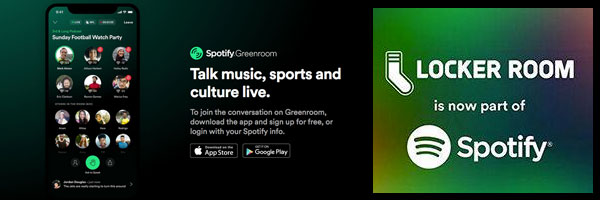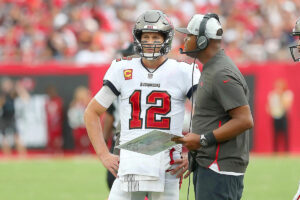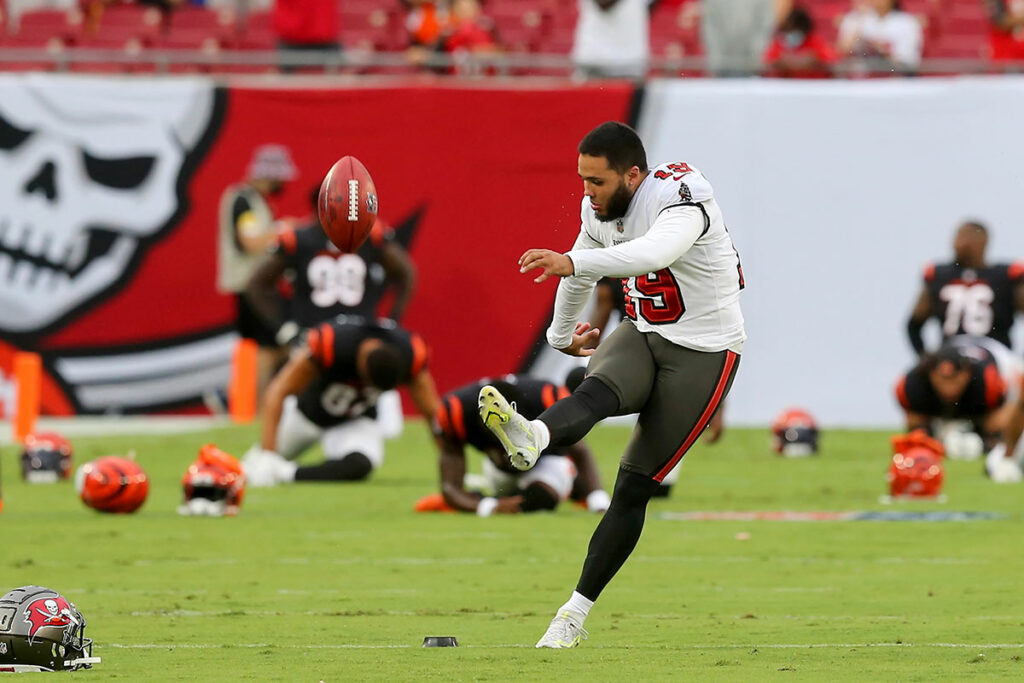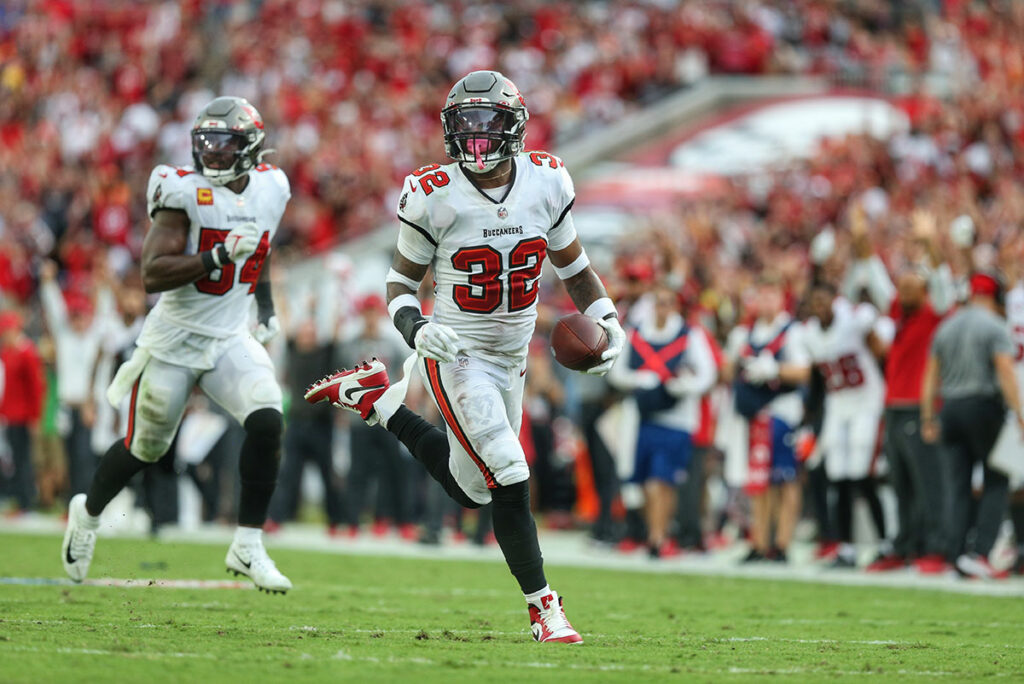
Bucs Briefing is exclusively sponsored by Spotify Green Room: Tap In, Talk Sports – the official social audio partner of PewterReport.com.
Spotify Green Room is changing the way we talk sports (and talk about the Bucs!). It’s the only place for live audio conversations about the takes, rumors, news, and teams you care about.
React to sports news as it happens. Gather all your friends in watch parties for the biggest games. Rep your favorite teams and find your community. Better sports talk is just a tap away — download on the Apple App Store and join the conversation!
Welcome to the new in-season edition of Bucs Briefing! From now on, my weekly column will appear each Wednesday morning, typically detailing seven key observations from the team’s most recent game. We’ll look at tape, scheme and major storylines as we get ready to close the door on one game, and open the door on the next. Enjoy!
7. Byron Leftwich Is Evolving
Through two weeks of the season, it is hard to imagine being more impressed with Bucs offensive coordinator Byron Leftwich. In Week 1 he got aggressive early, throwing the ball in plenty of neutral situations, even with the lead. The Bucs’ pass-heavy approach allowed them to prevail even on a night when their defensive struggled in a 31-29 victory. Accompanying the typical downfield shots in the Bucs offense was an evolution of Tampa Bay’s quick-game passing attack. It was a clinic on multiple ways to beat a defense, and the show continued on Sunday against Atlanta in a 48-25 win.
Leftwich made his approach clear from the start of the game: the Bucs were going to bury the Falcons with play-action passing and early down throws. Thirty-five percent of Brady’s dropbacks (14-of-39) were play-action passes, the second-highest percentage of any game since the veteran quarterback donned the red and pewter. The only Bucs game with a higher percentage of play-action passes was Super Bowl LV.
The #Bucs were under center for 62% of their offensive snaps against the #Falcons.
They’ve only been under center at a higher rate once in the Brady-era — Super Bowl 55.
— Paul Atwal (@AtwalNFL) September 20, 2021
The process has been remarkably productive for the Bucs offense. On Sunday, Tampa Bay averaged 2.9 more yards per passing attempt on play-action passes than regular dropbacks. The Bucs were great on non-play-action attempts too, but the play-fakes gave them another dimension to shred Atlanta. Brady finished 10-14 for 134 yards and two touchdowns while averaging 9.6 yards per attempt off play-action passes in Week 2.
If the Bucs can maintain consistency with their approach to play-action passing, it’ll pay dividends for this offense.
6. Bucs Offense Dominating First Down
I spent most of last year imploring the Bucs to become a more pass-heavy team on first downs, after they spent most of 2020 determined to get to 2nd-and-8. After the 2020 bye week, Tampa Bay’s neutral situation pass rate began to increase. This was a huge reason for the team’s offensive turnaround over the final eight games of the season.
Two weeks into the 2021 season, and it seems Leftwich has learned his lesson. Tampa Bay has the highest early down pass rate in the NFL above expectation as we head into Week 3. The Bucs are throwing when opponents are expecting runs, and the results have been outstanding.
Early-Down pass rates over expected through week 2 (pending MNF).
Look at TB/LV/DAL! pic.twitter.com/Lrc0cTiu58
— Computer Cowboy (@benbbaldwin) September 21, 2021
Because Leftwich and Co. are keeping opposing defenses off-balance, it’s opening up a world of possibilities for the Bucs offense. They have the league’s fourth-highest overall success rate and fifth-highest dropback success rate on first down. More importantly, Brady has the third-highest EPA/play (Expected Points Added Per Play) amongst all quarterback when throwing on first down.

Bucs QB Tom Brady and OC Byron Leftwich – Photo by: Cliff Welch/PR
This is doing two things for the Bucs: putting them in more advantageous second down situations, and allowing them to run the ball more effectively when they do run on first down. Tampa Bay’s second down EPA/play of 0.297 and first down rush success rate are both sixth best in the NFL. By throwing more on first down, the Bucs are making themselves less predictable for opposing run defenses, and putting themselves in more favorable second down situations.
Now, Tampa Bay has not been as good on third down this season as it should be, which needs to improve. Through two games, the team is 9-23 on third down, which puts them around league average. The good news is that three of those 14 failed first downs came due to dropped passes. If those passes had been caught, the Bucs would be in the Top 5 in third down conversion percentage. That’s also a good reminder that we are dealing in small sample sizes here. Draw any broad conclusions at your own risk.
But small sample sizes or not, the Bucs are better at avoiding third down altogether this season, with just 23 attempts on the season. Twenty teams have been in more third down situations than Tampa Bay. The Bucs percentage will improve on third down, but by winning first down more often, they’ll also be in less do-or-die situations throughout the season.
5. Context Needed When Condemning Bucs Secondary
Two weeks into the season, and only two teams have allowed more passing yards than the Bucs defense. Defensive coordinator Todd Bowles’ unit has permitted two 300-yard passers in as many games, while allowing both Dak Prescott and Matt Ryan to be remarkably efficient. The duo has combined to complete 72.6 percent of their passes against the Bucs, an impossibly high number that is somehow still just fifth-worst in the NFL.
It’s a disaster, right?
Eh, not exactly. Well, maybe. But some important context is needed to understand those numbers.

Bucs DC Todd Bowles – Photo by: Cliff Welch/PR
First, some of this is by design. Bowles’ defense is built on shutting down the run, preventing big plays down the field and getting pressure on the quarterback. The Bucs deploy softer zone coverage and rely on their team speed to rally and tackle to limit gains after the catch. In Week 2, Ryan attempted just two passes of 20-plus yards, failing to complete either. The week prior, Prescott was 2-7 on deep balls, one of which came at Sean Murphy-Bunting’s expense.
Bowles believes that as long as the Bucs keep the ball in front of them, tackle the catch and get pressure on opposing quarterbacks, his defense will be successful. Is he right? Tampa Bay won the Super Bowl last year, but that wouldn’t have happened if Bowles didn’t drastically change his defensive approach in the playoffs. In 2021, we’ve seen the exact same defensive tendencies Bowles deployed during the 2020 regular season, with the same questionable results.
Another huge aspect of this is volume. Last year the Bucs were the most-passed against defense in neutral situations across the entire NFL. That’s the by-product of having the league’s best run defense since 2019. Nothing has changed in 2021, with the Bucs facing 15 more pass attempts than the next closest team. Constantly inviting teams to throw the football against you is a dangerous way to live when facing quality quarterbacks. It’s a huge reason why the score has been closer in Weeks 1 and 2 than it should have been.
Despite the schematic flaws that opposing offenses have revealed in the Bucs defense, some fans have rushed to blame Tampa Bay’s young defensive backfield. I don’t think that’s entirely fair. Jamel Dean struggled a bit in Week 1, but was very good in Week 2. Carlton Davis III has been outstanding in both games this season. None of the Bucs three safeties have surrendered a big play in the passing game, and the trio combined for five forced incompletions/interceptions on Sunday.
Yes, Ross Cockrell has struggled a little bit, but some of that is how he’s asked to play in the slot. He’s going to give up yards underneath in zone, as are Devin White and Lavonte David, to a degree. White must do a better job of tackling and anticipating in coverage. He’s been a weak spot through two games. But most of the rest of the Bucs back seven has been solid or better through two games. Don’t blame the players for a schematic flaw that teams are attacking.
4. Joe Tryon-Shoyinka Is This Close
It will sounds blasphemous to some, but Joe Tryon-Shoyinka might already be the Bucs’ best one-on-one edge pass rusher. In fact, I’m sure he’s a better one-on-one edge rusher than Jason Pierre-Paul. Pierre-Paul is unquestionably the better all-around player, and probably knows the defense better as well. Both he and Shaq Barrett are versatile edge rushers who play the run at an extremely high level. This is not meant to be a shot at those two players.
But Tryon-Shoyinka brings a combination of athleticism and pass rush sophistication that those other two guys do not have. His explosiveness coupled with quick and deadly rush moves cannot be given just eight pass rush snaps a game.
That’s one of the better left tackles in the game that Tryon-Shoyinka is making quick work of with a stab-swim move. Vita Vea knocks the rookie off of his first NFL sack, but we already saw what we need to see from an evaluation standpoint. It’s the same thing we’ve seen in every game Tryon-Shoyinka has played in. A player with his ability must see an increase in pass rush reps.
If teams want to throw against the Bucs at such a ridiculously high rate, Tampa Bay needs to dare them to run the ball. Line up with Pierre-Paul at 3-technique next to Vea, with Barrett and Tryon-Shoyinka off the edge on 2nd-and-long. Certainly do it on far more 3rd-and-longs or 2-minute situations. Atlanta’s unique personnel usage admittedly made this tough for Bowles, but it’s an adjustment he should make moving forward.
3. Will Gholston Quietly Good
I try to take at least a couple times a year to write about Will Gholston, because I know we’ll hardly ever talk about him otherwise. The unsung hero of the Bucs defense, Gholston is the second-longest tenured Buc despite never being a full-time player. Not many players of Gholston’s ilk stay in one place their entire career, but nine years later, the 30-year old is still a Buc. And on Sunday, it’s a good thing he was.
Gholston played exactly half of the Bucs defensive snaps on Sunday, but boy, he made them count. On 36 plays, Gholston picked up three tackles, a tackle-for-loss and a couple of pressures.
Gholston is so big, long and strong, it’s almost unfair when he decides to slant gaps and cross the face of his opponent. Nobody will ever call Gholston ultra-explosive, but training with Ndamukong Suh in the offseason and working under defensive line coach Kacy Rodgers has paid dividends for the veteran. He’s a far more difficult player to block than he was three years ago.
Before the arrival of Bowles and Rodgers, Gholston was a relative non-factor as a pass rusher. Now he’s useful up-and-down the line on passing downs. Here he is working over Pro Bowl left tackle Jake Matthews with a series of power moves to flush Matt Ryan from the pocket.
Gholston’s calling card is still his size and strength. His frame is truly remarkable at 6-foot-6 with 34-inch arms and hardly an ounce of fat on him. When Gholston’s pad level is right, opposing offensive linemen go backward. He put Falcons first round right tackle Kaleb McGary in his running back’s lap on third-and-short on Sunday.
Gholston is in a contract year, but with Suh and McLendon potentially retiring after the 2021 season, odds are still good he’ll be back in Tampa Bay. If he keeps playing like this, he’ll drive the price up for the Bucs this offseason.
2. Devin White’s Slow Start
It hasn’t been a disastrous start to the 2021 season for Devin White, but it hasn’t been good either. Granted, opposing teams have not tried to run the ball much against Tampa Bay, so a major part of the LSU product’s game isn’t on display. But White hasn’t shown much improvement in coverage, and he’s been totally out of control in space. As a result, the third-year linebacker’s tackling has suffered. White was the cause of a few big plays for Atlanta on Sunday, including two third down conversions.
The broadcast replay actually had a great view of this play, as White sees it all the way, but hesitates to jump the route. As a result he’s late getting to the ball, Kyle Pitts is able to make the catch and White obliterates Lavonte David rather than at least making the sure stop on the tight end. Pitts picks up a huge gain, and the Falcons offense is off and running.
On another third down later in the game, White missed a point-blank sack of the “elusive” Ryan, who completed the pass for a first down.
If this were a rare occurrence it would be one thing. But it’s not. I’ve got at least five plays from White on Sunday that are just him playing completely out of control. White plays with a lot of energy, and that’s easy to appreciate about him. But it also gets him into a lot of trouble. If he’s going to make the leap to elite NFL linebacker this season, he needs to clean up the mistakes.
1. Laugh A Little
Not only is Rob Gronkowski dominating on the field for Tampa Bay, but he genuinely seems to be enjoying himself again. If you recall after his Patriots tenure, Gronkowski said, “I was not in a good place. Football was bringing me down, and I didn’t like it. I was losing that joy in life.”
Watching him on the ESPN2 Monday Night Football broadcast with Peyton and Eli Manning, I was reminded to celebrate the human being victories in this sport, as well as the on-field ones.
Gronk says he watches zero film and just asks Tom Brady who’s covering him every week https://t.co/xJJHdQkS6o
— Gifdsports (@gifdsports) September 21, 2021
Jon Ledyard is PewterReport.com's newest Bucs beat writer and has experience covering the Pittsburgh Steelers as a beat writer and analyzing the NFL Draft for several draft websites, including The Draft Network. Follow Ledyard on Twitter at @LedyardNFLDraft




